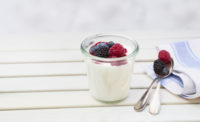
In Living Color
Labels with eye-catching graphics make dairy products pop on the shelf.
by Shonda Talerico Dudlicek
Creating some of the
beautiful designs found on today’s dairy products takes coordination
among the digital, graphics, labeling and packaging worlds.
But suppliers are meeting these needs of dairy
processors, who also want their labeling and graphics needs fulfilled
quickly.
Designing packaging can be an expensive,
time-consuming task, but is made easier by full-service graphics
departments equipped to design a logo or package all the way through to
printing the label on the actual package.
Digital services have hastened the work flow, and
Duncan, S.C.-based Cryovac utilizes digital printing in its full-service,
in-house graphics department. Services range from conceptual design work to
the required printing plates.
Images and proofs are sent digitally, rather than
physically, from plant to plant, saving time. “We can go directly
from the computer to a substrate and make prototypes for customers so they
can use those at photo shoots or market surveys, or for product testing for
size and distortion,” says Roxanne Baker, graphics team leader at
Cryovac’s Simpsonville, S.C., manufacturing facility. “That is
a trend we’re seeing, that customers need to see more of that
prototype packaging.”
Cryovac prints products, makes shrink bags and thermo
films, and packages dairy products ranging from blocks of cheese to bags of
dairy powders. “Trying to shrink wrap a wedge of cheese may present
its own challenges. That’s something that’s very difficult to
lay out art to follow on correct placement because of the size and shape.
So we use prototype packages that are printed on a digital press to help a
customer test,” Baker says.
Full-Service Labeling
Cryovac’s graphics department is at the
manufacturing plant, which is advantageous for the customer, says Chuck
Dunlap, marketing director of the dairy packaging business in Duncan, S.C.
Customers can visit one location “for a trial, stand on the floor and
watch their art run,” he says, “decide if they like it or they
want a change, go next door to the graphics office and make that change, go
back out and see it run again.”
Ameri-Seal, Chatsworth, Calif., also performs smaller
print runs for test marketing, which is becoming increasingly popular, and
helps dairy processors keep their costs down.
“The customer sends us their empty bottles and
containers and we sleeve the product at our facility using heat/steam
tunnels. We then send the empty containers back to the customers for them
to fill. This is an added service when customers order film from us. They
want unique packaging to help make their products pop on store
shelves,” says Devin Millstein, Ameri-Seal’s marketing vice
president.
Ameri-Seal is a manufacturer and converter of PVC,
PETG and OPS heat-shrinkable sleeves, focusing on tamper-evident seals such
as clear and printed shrink bands. Ameri-Seal also supplies bands called
pre-forms, which create a tamper-evident seal around the tops of cottage
cheese, yogurt or sour cream tubs.
Ameri-Seal has a full-body sleeve for single-serve
milk and yogurt containers. Up to nine colors can be printed on these
sleeves with Ameri-Seal’s rotogravure printing process. High-shrink
heat-shrinkable sleeves, with up to 80 percent shrinkage, allow customers
to put heat shrinkable labels on unusually shaped bottles, jars and
containers, Millstein says.
“But another cutting-edge service today that
wasn’t around a few years ago is the digital proof process.
Ameri-Seal supplies digital proofs of printed sleeves upon request. This
shows customers their completed design and product within days rather than
weeks. Digital proofs are a great benefit to customers in a hurry to see
their completed products,” Millstein says.
Fort Dearborn Co.’s products and processes
include low-shrink PETG shrink film, catalyzed water based inks for process
printing and enhanced product resistance for full body shrink sleeves. The
company also installed digital presses at multiple locations.
“With digital printing, product concepts and
design alternatives can be produced quickly — usually within 24 hours
— on virtually any substrate, allowing creative service marketers and
packaging engineers to visualize a variety of graphic effects and
decoration options without breaking the bank,” says Michele Donahue,
marketing communications coordinator at Elk Grove Village, Ill-based Fort
Dearborn.
SleeveCo, Dawsonville, Ga., offers a full line of
application equipment and experienced support staff, beyond its line of
full-body labels, tamper-evident bands and other products in PVC, HS-PVC
and PETG films.
In labeling technology, servomotors are the latest
advancement. B&H Labeling System’s new high-speed Marathon XL
roll-fed labeler SMARTdrive has an all-electronic drive train,
digital, multi-axis servomotor control.
“Dairy processors are looking for labeling
machinery that produces attractive containers, to maximize the shelf impact
of their products while minimizing costs,” says Roman Eckols,
president of B&H Labeling Systems, Ceres, Calif. “Traditionally,
dairy processors have used shrink-sleeve labeling technology to handle
contoured containers but this type of equipment is very complex.
“Processors are now increasingly asking for
labeling machinery that achieves this same high level of product shelf
appeal while improving productivity. The Marathon roll-fed labelers from
B&H, coupled with a downstream shrink tunnel, allow dairy processors to
label contoured containers while greatly simplifying the labeling operation
for improved reliability and uptime.”
Osio International Inc. manufactures shrink-sleeve
labels, heat- and cold-seal roll-stock and woven polypropylene bags. The
company developed thinner gauge PET-G film and recently rolled out
holographic metallized shrink sleeve labels.
“Shrink-sleeve labeling has grown in popularity
each year for the last decade. A significant effect of the use of shrink
labeling is the development of custom-shaped containers. A flat labeling
surface is no longer a requirement, so we are seeing bottles created
specifically for the label instead of the other way around,” says
Rick Whipple, vice president of Anaheim, Calif.-based Osio International.
Milk that Pops
As dairy faces greater competition at the grocery
store, packaging needs colors and designs that really pop. A 3-D or an embossed-look label are what some dairy
processors are asking for, says Baker. Screens or dots can create new
effects like feathered edges and color gradients.
“When you screen colors, you use as few colors
as possible but screen them in such a way to produce more and more colors.
The product pops on the shelf so it appeals to the consumer’s
attention,” Baker says. “Layering similar colors is very common
now. We’re seeing the layering of color to build effect or saturation
just for the shelf appeal of it.”
Metallic and black inks are popular for high-end
products. Green is often chosen for a “positive environmental
scene,” Dunlap says. “As people try to find a niche to
differentiate them from a commodity, colors can be an avenue for doing
that, for instance, people making an organic product and their typical use
of green.”
Colors have long been used in packaging to
differentiate products in the line, such as red caps for whole milk and
blue caps for 2 percent milk. Dairy processors use colors in cheese
packaging to establish differences in product quality and extension, Dunlap
says. “People are packaging their extra-sharp cheddar in black and
perhaps product that hasn’t been aged as long in a different
color.”
Millstein says the most popular design trend
she’s seen is 360-degree graphics on containers, bottles and jars.
“Heat-shrinkable sleeves allow this type of coverage. The benefit is
more real estate for art, verbiage and design. And again, metallic inks and
see-through film panels are rising in popularity,” she says.
“Paper labels used to be more popular, but not anymore. The PVC,
PETG, OPS heat-shrinkable sleeves are slicker in design and appearance and
help create major product buzz.”
The use of shrink-sleeve labels has been steadily
increasing in the dairy industry, Donahue agrees. “The demand for
impactful graphics is growing due to the rise of competition in the
marketplace. Colors and designs vary from product to product, but the dairy
industry is always looking for innovative packaging as well as vivid,
bright colors,” she says. “The basic product is still the same
but the flavors, packaging, sizes and colors are constantly
changing.”
Fort Dearborn’s HiColour printing system
incorporates design, prepress, color management and printing, and it
recently added a seventh color. The HiColour system delivers up to 85
percent of PMS colors and creates packaging with rich, vibrant colors so
products stand out on a store shelf, Donahue says.
“Dairy processors have really tried to transform
milk into a suitable alternative for those now living in the world of
convenience. Convenience is becoming a major trend in almost every
industry, and each brand marketer is looking at ways to transform their
product into the ideal convenience product. Single-serve milk cartons are a
perfect example of that,” Donahue says. “Also, the idea of
putting milk in bottles that are created for vending machines transformed
the thinking of brand marketers when choosing their container. Revolution
in the marketplace has caused brand marketers and dairy processors to
continue reinventing their products to stay competitive.”
Thermochromatic inks – inks that are sensitive
to temperature changes – are also hot. Farmingdale, N.Y.-based
Seal-It Inc. uses thermochromatic inks to imprint disappearing and
reappearing messages, says Sharon Lobel, the company’s president and
chief executive officer.
“We can print on a milk bottle,
‘Refrigerate me,’ and you don’t see it. But when it gets
to a certain temperature, when it gets too warm, when it’s sitting on
your kitchen table, that message will pop out. You put it back in the
refrigerator and the message goes away,” she says.
“Thermochromatic can be adjusted to any temperature, so it can go
from hot to cold, cold to hot.”
Tamper-evident bands have also received a makeover. At
Seal-It, processors are asking for the band to be color coordinated with
the product’s packaging. “One label has a horizontal
perforation around it with a tamper-evident band so when you twist the cap
around it breaks that perforation – throw out the tamper-evident band
and you’re left with a label,” Lobel says.
With a broad palette of colors available in screens
and complementary shades and full 360-degree coverage, dairy products are
transformed into works of art. “You can make your product very vivid
and your product sells. It’s the new way to go. It’s so much
more effective than a carton. Milk cartons used to be very blah and now you
have a new generation and it’s very exciting. Each one is more
beautiful than the one before it. You see a lot of splashes or milk pouring
over or some splashes coming out of it,” Lobel says.
“It’s gotten very, very creative and the
labels are absolutely beautiful. You go into a supermarket and you can see
these labels from across the store. And that sells your product. If
it’s appetizing and colorful and beautiful, they’re going to
try it. And then it’s up to you if it’s going to work or
not.”
Shonda Talerico Dudlicek is a freelance
journalist and a former managing editor of Dairy
Field.
$OMN_arttitle="In Living Color";?>



